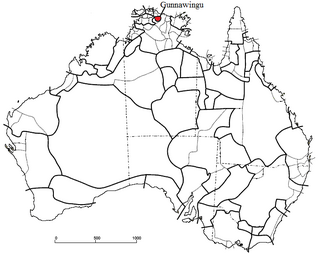Language
Guragone is a non-Pama-Nyungan language belonging to the Gunwinyguan family of languages, and has been described by Rebecca Green. It is one of the four Maningrida languages, the others being Ndjebbana, Nakkara and Burarra. Despite their genetic similarity, shared vocabulary rates are low, with 22% between Gurr-goni and Ndjebbana, and 24% between Gurr-goni and Nakkara. It has two dialects, associated with the two moieties, respectively gun-dakangurrngu Gurrgoni, or 'hard Gurr-goni' and gunnjalkitj or 'soft' Gurrgoni.

The Macro-Gunwinyguan languages, also called Arnhem or Gunwinyguan, are a family of Australian Aboriginal languages spoken across eastern Arnhem Land in northern Australia. Their relationship has been demonstrated through shared morphology in their verbal inflections.

Maningrida, also known as Burarran, is a small family of Australian Aboriginal languages spoken in northern Australia. It includes four languages, none closely related:
Country
The Gungorogone were inlanders living south of Maningrida, who dwelt in the area to the southeast of the headwaters of the Tomkinson River, on and to the west of the Cadell River.

The Cadell and Blyth Floodplains consist of the 432 square kilometres (167 sq mi) floodplain of the lower reaches of the Blyth and Cadell Rivers of northern Arnhem Land in the Top End of the Northern Territory of Australia. It is an important site for waterbirds.
Neighbouring tribes were the Dangkolo and Manengkererrbe clans to their west, Gunavidji and Nakkara on their northern frontier. Running clockwise, the Burarra and Gun-nartpa, Ngulinj clan, and finally, the Kardbam clan on their southern flank.
Ndjébbana, also known as Djeebbana, Kunibidji, Gunavidji, Gunivugi, or Gombudj, is a Burarran language spoken by the Kunibidji people of North-central Arnhem Land, Australia.
This page is based on this
Wikipedia article Text is available under the
CC BY-SA 4.0 license; additional terms may apply.
Images, videos and audio are available under their respective licenses.
Maningrida is an Aboriginal community in the heart of the Arnhem Land region of Australia's Northern Territory. Maningrida is 500 km (311 mi) east of Darwin, and 300 km (186 mi) north east of Jabiru. At the 2016 census, Maningrida had a population of 2,308.
Lester Richard Hiatt, aka "Les Hiatt", was a scholar of Australian Aboriginal societies who promoted Australian Aboriginal studies within both the academic world and within the wider public for almost 50 years. He is now regarded as having been one of Australia's foremost anthropologists
Gurr-goni, also spelled Guragone, Gorogone, Gun-Guragone, Gunagoragone, Gungorogone, Gurrogone, Gutjertabia, is an Australian Aboriginal language spoken in Arnhem Land. There were about 60 speakers in 2011, all trilingual in Burarra or Gunwinggu.
The Burarra, also referred to as the Gidjingali, are an indigenous Australian people in and around Maningrida in the Northern Territory. Opinions have differed as to whether the two names represent different tribal realities, with the Gidjingali treated as the same as, or as a subgroup of the Barara, or as an independent tribal grouping. For the purposes of this encyclopedia, the two are registered differently, though the ethnographic materials on both may overlap with the other.

The Gunwinggu people are a tribe of Australian Aboriginal people, forming part of the Bininj Gun-Wok peoples, who live to the east of Darwin, Northern Territory.
Burarra is an Australian Aboriginal language spoken by the Burarra people of Arnhem Land. It has several dialects.
Rembarrnga (Rembarunga) is an Australian Aboriginal language. It is one of the Northern Non-Pama–Nyungan languages, spoken in the Roper River region of the Northern territory. There are three dialects of Rembarrnga, namely Galduyh, Gikkik and Mappurn. It is a highly endangered language, with very few remaining fluent speakers. It is very likely that the language is no longer being learned by children. Instead, the children of Rembarrnga speakers are now learning neighbouring languages such as Kriol in south central Arnhem Land, and Kunwinjku, a dialect of Bininj Gunwok, in north central Arnhem Land.
The Gunavidji, also written Kunibidji or referred to as the Ndjébbana, are an indigenous Australian people of Arnhem Land in the Northern Territory.
The Nunggubuyu are an indigenous Australian people of eastern Arnhem Land in the Northern Territory.
The Djinang are an indigenous Australian people of the Northern Territory.
The Djinba are an indigenous Australian Yolngu people of the Northern Territory.
The Yan-nhaŋu, also known as the Nango, are an indigenous Australian people of the Northern Territory. They have strong sociocultural connections with their neighbours, the Burarra, on the Australian mainland.
The Dangu are an indigenous Australian people of Arnhem Land, in the Northern Territory. They are, according to Norman Tindale, to be carefully distinguished from the Djaŋu.
The Djaŋu, otherwise written as Djangu, are an indigenous Australian people of the area of Arnhem Land in Australia's Northern Territory.
The Gadjalivia were an indigenous Australian people of Arnhem Land in the Northern Territory. They are now regarded as extinct.
The Dalabon or Dangbon are an indigenous Australian people of the Northern Territory.
The Watta were an indigenous Australian people of the Northern Territory.
The Yunggor were an indigenous Australian people of the Northern Territory




